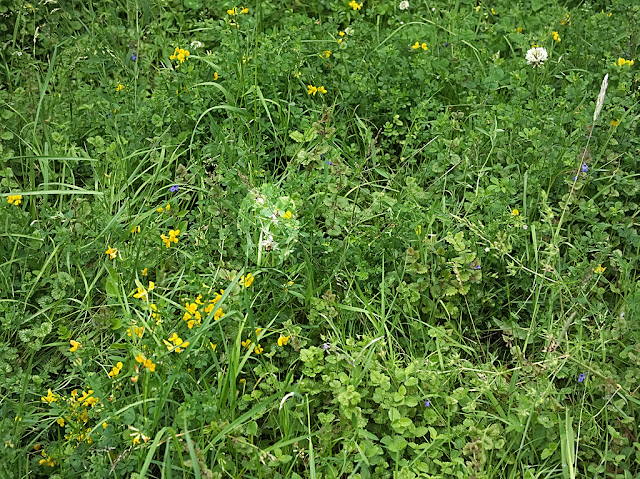 |
| Bee Orchid - 9 June 2017 All that wonderful mimicry wasted in England |
The bee orchid is interesting, not only for its bee like flower, but also because it has evolved two separate mechanisms of pollination. The first is through bees that are lured to its bee-like flower with its promise of a mate. The second is self pollination. Unfortunately, the bee that the flower has so carefully evolved to mimic does not occur in England, and so the bee orchid is left to self pollinate. This means, that at the cost of some loss of genetic diversity, the bee orchid can extend its range beyond that of relevant bee.
 |
| Site of Bee Orchid - 9 June 2017 Bee orchid barely visible in the bird's foot trefoil, ground ivy and grass |
Bird's Foot Trefoil
As the image above shows, the bee orchid that I photographed was in a mass of other plants including some bird's foot trefoil. In fact, I only spotted the bee orchid because I was trying to get a close up of the trefoil.
 |
| Bird's Foot Trefoil - 9 June 2017 |
Bird's foot trefoil gets its name from the arrangement of its black seed pods which is said to resemble a bird's claw. For a plant that seems to have no medicinal or culinary uses, and only minimal folklore, it has collected a huge collection of common names including: grandmother's slippers, ladies shoes, Gods almighty thumb and finger, kings fingers, granny's toenails, crow's toes, ladies shoes and stocking, bacon and eggs, and lady's slipper.
Lady's Bedstraw
 |
| Clump of Lady's Bedstraw - 9 July 2017 This clump was found growing among the nettles at the south end of the park |
The other surprise was to find a clump of lady's bedstraw growing in the park. This is common enough on chalky ground, but is not normally seen in the rich peaty soil of the Cambridgeshire Fens. There is an interesting contrast between lady's bedstraw and bird's foot trefoil: both have minimal folklore associated with them; but where the trefoil has many alternative names, bedstraw has few; and where trefoil has almost no uses at all, the bedstraw was a really useful plant. As it's name suggests, it was used to fill mattresses, as a flea repellent, as a cheese coagulant, and to colour Double Gloucester cheese. Medicinally, it was used as a remedy for gout, epilepsy, and urinary tract infections.
St John's Wort
 |
| St John's Wort - 14 June 2017 |
The final plant I want to highlight in this post is St John's wort, or more specifically, woody St John's wort (Hypericum prolificum). As far as I am aware there is just a single plant of this flower on the North bank of Todd's Pit. Hypericum is a large varied genus including low growing herbs through to trees that reach a height of 12m. Confusingly, all members of the genus may be called St John's wort, derived from its flowering on St John's day - 23th June.
Next: Flower Meadow
No comments:
Post a Comment